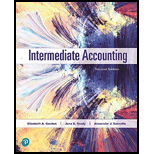
Basis for Conclusions Case 1: Judgment and Estimation Uncertainty
Unlike U.S. GAAP, IFRS requires that an entity disclose (a) management’s judgments with the most significant effect on the financial statements and (b) information about the major sources of estimation uncertainty that may result in a material adjustment to the carrying values of the entity’s assets and liabilities. These disclosure requirements are included in IAS 1, “Presentation of Financial Statements.” Paragraph 122 contains the requirement related to judgments and paragraph 125 contains the requirement related to estimation uncertainty.
Read paragraphs BC77 through BC84 in the basis for conclusions in IAS 1. What reasons did the Board give for requiring the disclosures about judgment? What reasons did the Board give for requiring the disclosures about estimation uncertainty?
Want to see the full answer?
Check out a sample textbook solution
Chapter 3 Solutions
Intermediate Accounting (2nd Edition)
- Need help with this question solution general accountingarrow_forwardFantom Enterprises sells on terms of 3/12, net 40. Gross sales last year were $520,000, and accounts receivable averaged $70,000. Half of Fantom's customers paid on Day 12 and took discounts. a) What are Fantom's sales net of cash discounts taken? b) What is the total dollar finance charge paid by the non-discount-paying customers? Helparrow_forwardDaisy Inc., wants to make a profit of $25,000. It has variable costs of $80 per unit and fixed costs of $15,000. How much must it charge per unit if 4,000 units are sold? ?!arrow_forward
 Auditing: A Risk Based-Approach to Conducting a Q...AccountingISBN:9781305080577Author:Karla M Johnstone, Audrey A. Gramling, Larry E. RittenbergPublisher:South-Western College PubBusiness/Professional Ethics Directors/Executives...AccountingISBN:9781337485913Author:BROOKSPublisher:Cengage
Auditing: A Risk Based-Approach to Conducting a Q...AccountingISBN:9781305080577Author:Karla M Johnstone, Audrey A. Gramling, Larry E. RittenbergPublisher:South-Western College PubBusiness/Professional Ethics Directors/Executives...AccountingISBN:9781337485913Author:BROOKSPublisher:Cengage Intermediate Accounting: Reporting And AnalysisAccountingISBN:9781337788281Author:James M. Wahlen, Jefferson P. Jones, Donald PagachPublisher:Cengage Learning
Intermediate Accounting: Reporting And AnalysisAccountingISBN:9781337788281Author:James M. Wahlen, Jefferson P. Jones, Donald PagachPublisher:Cengage Learning Auditing: A Risk Based-Approach (MindTap Course L...AccountingISBN:9781337619455Author:Karla M Johnstone, Audrey A. Gramling, Larry E. RittenbergPublisher:Cengage Learning
Auditing: A Risk Based-Approach (MindTap Course L...AccountingISBN:9781337619455Author:Karla M Johnstone, Audrey A. Gramling, Larry E. RittenbergPublisher:Cengage Learning




